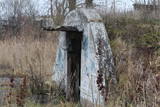Memories of the Spilve Helicopter Base
Were they military or civilian? Probably both kinds. Children just loved them – we ran along with them, threw our hats in the air and yelled “hooray, hooray!” Then we played the most popular game of the day – a little “war” in which “we” usually defeated the “Germans.”
There was a helicopter base in the South-western part of the Spilve airport during Soviet times. It was very visible from the forested dunes of Kleisti and from the branch of the Rīga-Bolderāja railroad which led to the Rīga Lacquer and Paint Factory. Helicopters crossed Iļģuciems and Pārdaugava at least twice a day at that time, creating huge noise. Were they military or civilian? Probably both kinds. Children just loved them – we ran along with them, threw our hats in the air and yelled “hooray, hooray!” Then we played the most popular game of the day – a little “war” in which “we” usually defeated the “Germans.” The site of the helicopter field can still be seen today. To the West of the base was the forest of Kleisti with a high dune that was known in the 1970s and 1980s as the Radar Hillock. There were two radars in Soviet times (later – just one) which continually spun on their axis. Apparently they were part of the airfield’s communications system. The hillock had a barbed wire fence around it, but there were no restrictions in the nearby forest. Next to the hillock was an enormous farm where the Soviet military bred pigs. It was also very much visible from the top of the dunes. The hillock is still there, along with the cement foundations of the radars, but there is a true “pigsty” where the pig farm used to be. The territory looks worse now than it did a quarter-century ago. It sound be remembered that on the meadows upon which the airfield sat centuries later, the Spilva battles of 1701 were waged. That was a major military event for its age.
| Tourism objects involved in this story | ||
|---|---|---|
In the South-western parts of the former Spilve airfield, you can still see concrete areas on which Soviet-era military helicopters once landed. |
||









